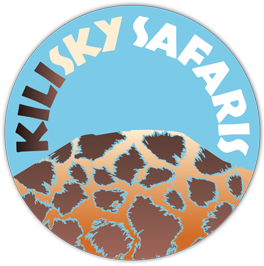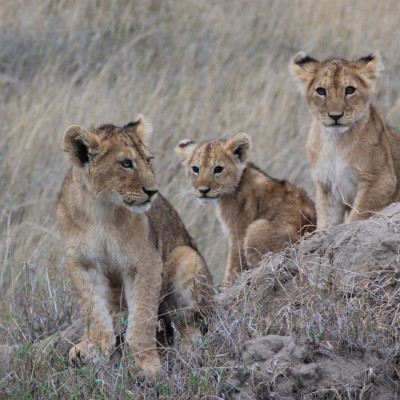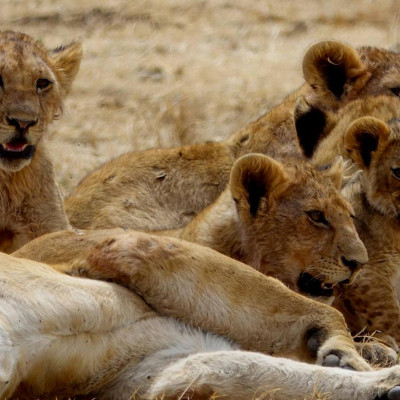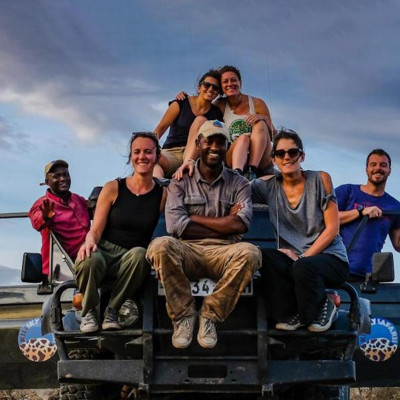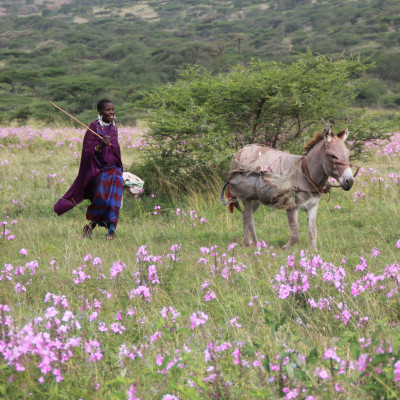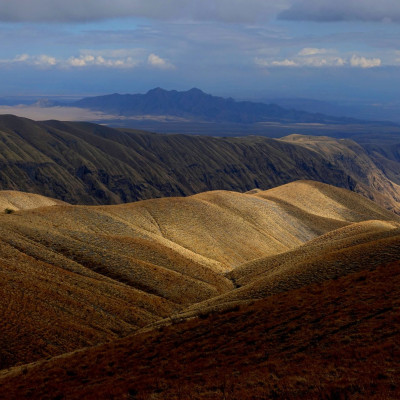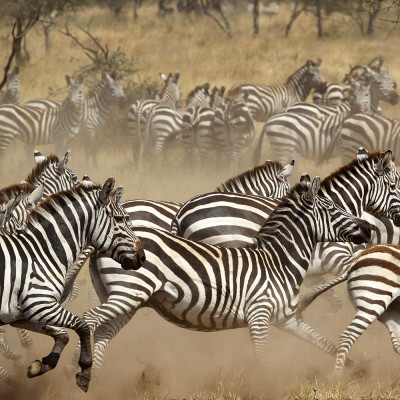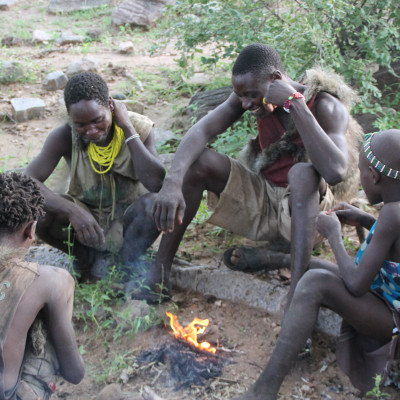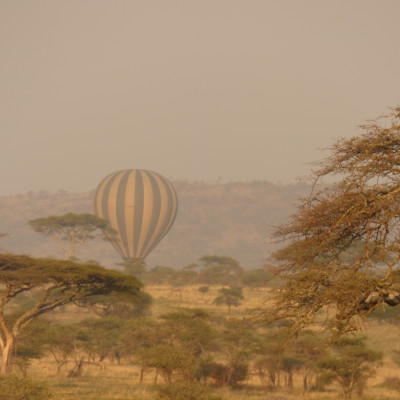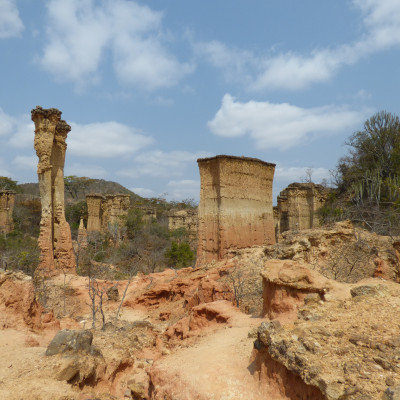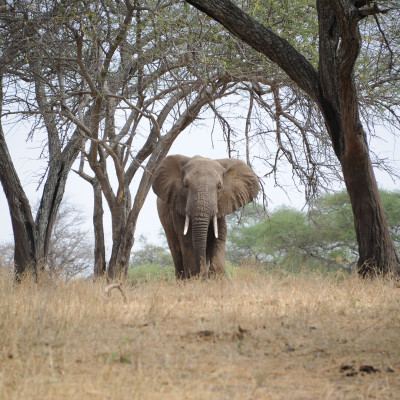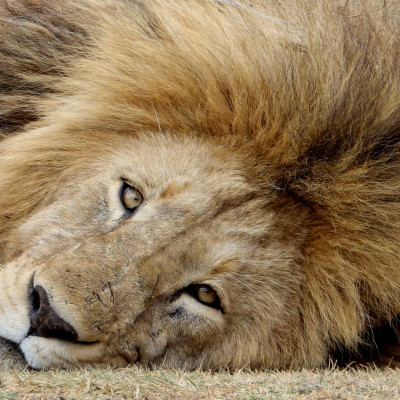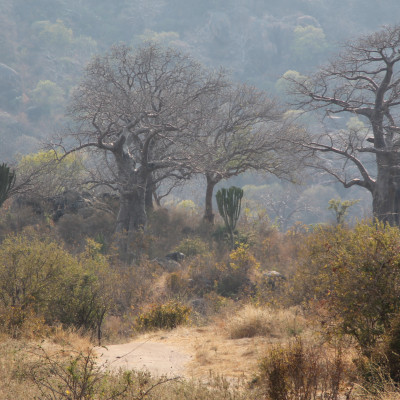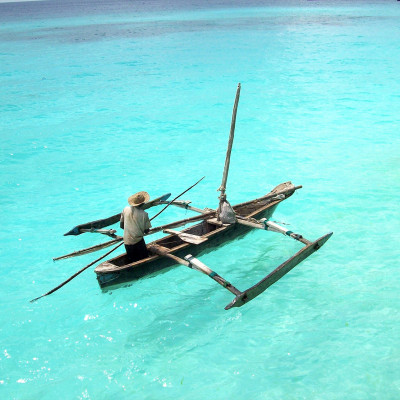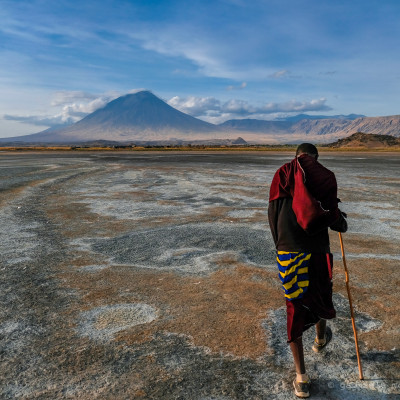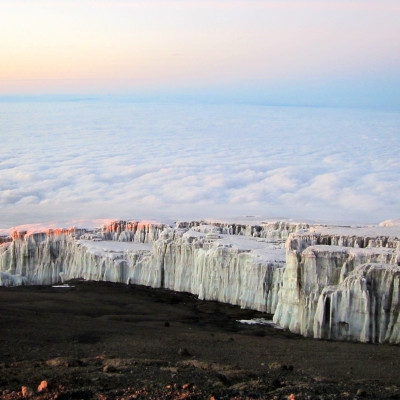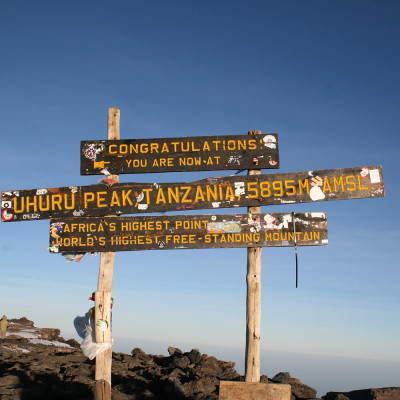02/12 Arrival - Arusha
We make a stopover at Zanzibar airport, where practically the plane empties, we remain in about ten people. We are a little perplexed, it will be that the exotic charm of the spice island attracts most visitors.
We arrive at Kilimanjaro airport around 7.30 am. As soon as we get off the plane we feel a slightly sweet smell of shrubs that will accompany us for most of our stay in Tanzania. We meet our guide, Eric, a young boy from Arusha who speaks Italian very well. On the way to the lodge many children of different ages walk along the roadside, wear uniforms, some reproduce the colors of the country's flag. The guide tells us that they go to school and can travel 4/5 km to get there and as many to go home. When the jeep slows down, they smile at us and greet happily. The lodge is located in a semi-rural hilly area, to get there we discover that the roads, like most of the ones we will travel on, are dirt, dusty and rather rough.
After a few hours of rest to recover from the night spent traveling, in the afternoon we take a tour of the city of Arusha and visit the colorful and crowded central market. Even before arriving in the market area, the edges of the streets are full of exhibits, everything is sold, although it seems to me that the shoe stalls are the most numerous. Then we enter the covered part, stalls full of fruit and vegetables, some unknown to me, seeds, spices, meats, shouting, smells and colors; the thing that strikes me are piles of dried fish that tell me to be one of the most frequent meals together with white polenta (ugali). Anyway Eric tells me that the market is not only for those who buy or sell, it is a meeting place, people from different villages meet, exchange information on acquaintances in common, a place of relationship and sociability. We also arrive at a traditional medicine stall full of jars with powders, leaves, roots, sprigs of plants. The majority of the population turns to these healers, where they can find effective remedies for some diseases, also due to the very high costs of conventional medicine. To be my first time in Africa, perhaps the impact is a little too abrupt and chaotic, I feel a little dazed, however it must be recognized that the pulsating life of the city passes through there.
Tanzania gruppo parchi del nord e tribù
SERENGETI, MIGRAZIONE, NGORONGORO, TARANGIRE, MANYARA, LAKE EIASY, LAKE NATRON, MONTE MERU
10 giorni / 9 notti gennaio 2020
Un viaggio completo nel Nord della Tanzania, tutti i parchi più gettonati, incontro con le tribù e la Rift Valley
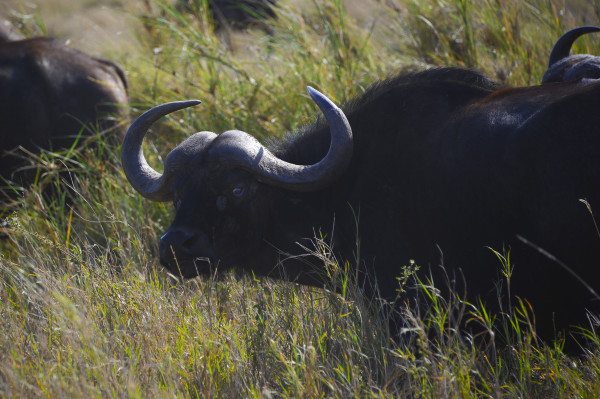
02/13 Arusha- Manyara Park- Karatu
In the morning we meet in Arusha the cook, Abdallah who will take care of the kitchen during the camping days. Cartons with various supplies and utensils are loaded onto the jeep, among other things I am surprised to see two trays of 36 eggs each, for 5 days of camping !? I will find that the hard-boiled egg is inevitable in the lunch box. After passing the hustle and bustle of the city we head towards Karatu, skirting some coffee plantations which, with corn, represent a good part of the crops present on these plateaus.
Karatu is a small town located in a magnificent well-cultivated hilly landscape, which is encountered along the path to the Manyara park. The guide gave us a little worried that it will be very difficult to see the arboreal lions, that is, those that climb trees, for which this park is famous; we reassure him by saying that we know the difference between the zoo and the park….
Although the park is one of the smallest, it alternates a varied and rich landscape of fauna; we find evergreen forests, stretches of savannah, streams, a marshy area, the river and a lake with their various vegetation. The first animals encountered are baboons, present in large numbers, then blue monkeys, families of elephants with babies, giraffes, zebras, buffaloes, water antelopes and warthogs. On the lake shore, among marshes and reeds, a myriad of colorful migratory birds among which magnificent crowned cranes stand out. Also from the lake you have a spectacular view of the Rift Valley. Even if we haven't seen the lions, the visit is worthwhile. In the evening we stay in a lodge with a beautiful garden near Karatu.
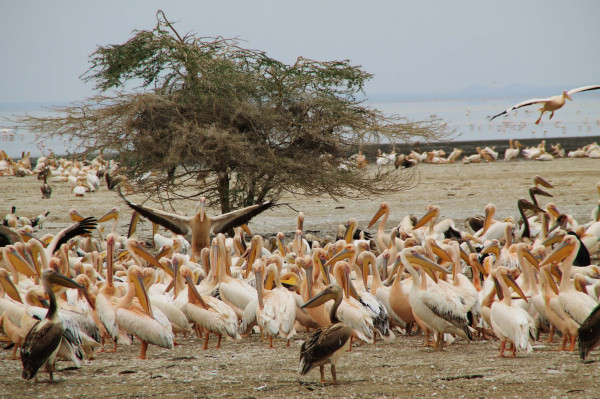
True Africa
What stages will give you real contact with the local population, far from the most tourist routes?
02/14 Karatu - Empakaay Crater
We start in the morning from Karatu towards Ngorongoro, after passing the park entrance we go up to the crater of the now extinct volcano, arriving on a balcony with an extraordinary view: the crater measures approximately 19 km in width and is surrounded by steep walls rich in vegetation, high about 500/600 mt. At the far end, all the animals graze, from prey to predators. After this spectacular view, instead of going down into the crater, like almost all the visitors, we walk along the edge of the crater to the right to go to the crater highlands area where we will carry out a trek that will take us near Lake Natron. This area is characterized by an elevated chain of volcanoes and calderas that rise along the Rift Valley in the eastern part of the park, with peaks ranging from 2500mt to 3600mt. After passing the ranger station at the intersection with the Lemala road, we no longer meet any tourists, and the first Masai settlements begin which, unlike other parks where they had to move, can live here. The primordial beauty of these villages is almost surreal: blue-green grass, herds that graze with zebras, straw and mud huts, a few jackals crossing the meadows, children with colored clothes who watch over their livestock. A mechanical inconvenience to the jeep slows down our journey, luckily nothing serious, meanwhile we enjoy the landscape.
We arrive a little late to the village of NainoKanoka next to the Olmoti crater, here we meet our Masai guide who will accompany us on the trek. His name is Macomero, a cute little man dressed in the classic red and black checked blanket and with the typical lance; joins us and we continue towards the Empakaay crater where we will camp, arriving on the edge in the late afternoon. Here too the view is spectacular, at the bottom of the crater a beautiful lake surrounded by steep rocky walls. Meanwhile, the porters with their donkeys also arrive, leaving in the morning from the village, because from here onwards the vehicles cannot reach the places where the trekking will pass, so the donkeys will be the support for the transport of tents, water and supplies .
Mount Meru Trekking and Ngorongoro Highlands
NGORONGORO, EMPAKAI, NAIOBI, ACACIA, NATRON, ARUSHA, MIRIAKAMBA, SADDLE, MERU SUMMIT
10 days / 9 nights
Walk on the paths of the Masai up to 4565 m of Mount Meru
While the tents are being assembled, with the Masai guide we descend inside the crater along a slightly steep but well-kept path, from where you can admire the views of the turquoise lake below; the rocky walls are covered with forest, there are trees with very long aerial roots, colorful flowers and birds, plants that are potted at home here are trees. The lake is populated by flamingos, some antelopes graze the grass just outside the forest, no noise except the wind, we just need some dinosaurs and then it seems to have returned to the dawn of the earth. In the evening we have dinner around the fire, the temperature is quite cool, we conclude the meal with a very substantial banana pudding (That's where most of the eggs have gone!).
The Masai guide, who speaks good English, tells us about the customs and habits of his people: shepherds who meet many of their needs with cattle breeding. During life, young people have to undergo a series of rites of passage, the first being that of circumcision, then they become young warriors and gradually up to senior of a higher level. Each level is characterized by tests, rights, responsibilities and a specific way of dressing. Polygamy is widespread and marriages are combined; I am of animist religion but there are also Catholics, like our guide, because as a young man he was at school by missionaries; he has a wife and six children. The time has come to retire for the night and I express doubts about the safety of sleeping in an unequipped camping site outdoors in such an isolated area. He calmly tells me that there is no problem, during the night we must not go out of the tent, if necessary we must stay within a meter, ending with a "sleep like a baby". He will stand by the fire all night.
The Great Migration
NDUTU, GRUMETI RIVER, KOGATENDE
Millions of wildebeests and zebras migrate hundreds of kilometers in search of pastures
The most spectacular natural phenomenon in Africa!
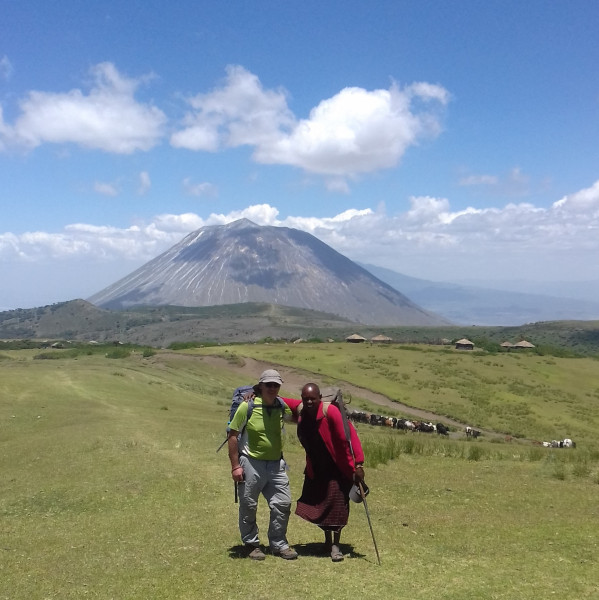
Tanzania Extensions
LAKE EYASI, LAKE NATRON, LAKE VITTORIA, OL DONYO LENGAY...
How to customize my tour?
Beyond the classic safari, to discover a land of unexplored beauty
02/15 Empakaay - Naiobi - Acacia
Early in the morning Eric with the jeep returns to the park entrance, we will meet again near Lake Natron. The donkeys are loaded and after taking a last look at the crater we walk towards the village of Naiobi. When the view opens, to the west we can glimpse Mount Merù and Kilimanjaro with the peaks covered with clouds, while in front of us the Ol Doinyo Lengai becomes increasingly visible, a still active volcano considered the sacred mountain by the Masai. It is Friday, market day, along the way some women join us. After a few hours of walking we arrive near the village, located in a green hilly area. The children are very intrigued, they follow us for some pieces of the road, I seem to have ended up in the elementary school subsidiary, huts, some huts with tin roofs, animal fences, small vegetable gardens and a lot of cattle everywhere, donkeys, sheep, goats and cows. The women are lined up with their bags of cereals for grinding in small mills, part of the market is for the sale of animals, for the rest they sell food, mainly cereals and beans.
After a snack on the meadow we continue the journey, the volcano now stands before us and the path descends slightly; we leave the park boundaries and the meadows gradually give way to the acacia plants, the younger ones with the bark of a beautiful yellow color, the soil becomes sandy and here and there stratified mica rocks emerge that easily flake off. Now the children who follow us play shyly to those who can touch us to give high five, their small hands are already so calloused. We reach the camping area located in a splendid position: a large grassy area in the shade of yellow acacias. While setting up the curtains, some children stand in a semicircle nearby and show necklaces and objects made with colored corals, then sing songs. Here and the superb starlings of a beautiful blue and red-orange color flutter among the trees.
In the evening a light drizzle arrives, in the season of small rains this late afternoon / evening rainfall is usual, we eat in a tent and our cook, after the inevitable soup entrèè, has prepared some excellent spaghetti with ragù.
Tanzania Safaris Northern Circuit parks
SERENGETI,NGORONGORO, TARANGIRE, MANYARA,
7 days / 6 nights
The TOP of the safari, the complete mythical Northern circuit.
02/16 Acacia - Lake Natron
Early in the morning the tents are dismantled, the donkeys are recharged and we continue towards Lake Natron. At the beginning we still walk in the acacia forest under a light drizzle, then the path opens, on the left the escarpment of the Rift Valley, now nearby, on the right the steep and whitish slopes of the Ol Doinyo Lengai volcano and in the distance in a halo a slightly pinkish you can see Lake Natron on the border with Kenya. In the meantime, two rainbows rain and come out, the landscape is truly beautiful. The volcano, still active, is very particular because it emits a lava rich in sodium carbonate which when it cools down after the emission, becomes white, in fact the top seems snow-covered instead it is lava. The path descends more rapidly between lava stone slabs where erosion has created a dense series of gullies until reaching the bed of a dry stream, but which will fill up in the now heavy rain season. After passing the stream, we go through a last grassy and sandy stretch, in the distance we see our jeep waiting for us at the meeting point.
Donkeys are unloaded, we thank and greet the Masai bearers who will return to their village of Nainokanoka on the same road traveled. We head towards the tented camp of Engaresero immersed in a beautiful grove near a river; the landscape has become decidedly drier and warmer. In the afternoon we make an excursion to the falls and go up the Ngare Sero gorge; the path crosses the stream of the same name several times, the water also reaches above the knee and every now and then you have to help yourself with your hands for the most difficult passages in the rocks. You arrive after about half an hour to the waterfalls that form a swimming pool in which you can swim. A little further on, in a kind of cave, another small pool with waterfalls with natural hydromassage. The water is fresh but not cold and a bath is a must.
Tanzania Safari The Wonderful South
RUAHA, UDZUNGWA MOUNTAINS, MIKUMI, ISIMILA, estention MAFIA ISLAND
9 days / 8 nights + Mafia Island
A wonderful Safari through the great and wild South
02/17 Lake Natron - Lobo (Serengeti)
In the early morning we go on a hike to the lake which is about 55 km long and 25 wide but is only 50/100 cm deep. We approach by crossing small streams with a few tufts of grass, fed by very alkaline underground sources that filter from the nearby volcano. There is a croaking of frogs behind a hill, but we cannot see a kingfisher, some Egyptian geese and other birds rummaging in the mud. The size of the lake varies greatly depending on the season and therefore the heat; particular bacteria that proliferate in alkaline waters produce photosynthetic pigments which, depending on the concentration, give colors that vary from blue to red and orange. This phenomenon is more visible, however, from above and not at the lake level. We approach the banks walking on the gray mud surface left uncovered, the water is immobile and populated by groups of flamingos who choose this area for nesting. Although the breeding season, which runs from August to October has ended, there are still large numbers of them, we try to get closer but inevitably they get up in the air moving every time to another part. We go around the muddy shores of the lake, the landscape despite being wild and inhospitable, with scarce vegetation and temperatures that can become extreme, has its desolating and almost unreal charm.
We set off straight for the Serengeti park, skirting the lake shore. We say goodbye and thank the Masai guide Macomero that we leave to a village outside Engasero where he will find a way to return to his village. The road climbs the escarpment of the Rift Valley on a very rough terrain of stony ground in a semi-desert landscape. We then cross the Loliondo region, for some stretches full of well-cultivated fields, where a Chinese company is building a very large asphalt road parallel to the dirt road. Then the territory becomes bare and rocky again, we pass close to the border with Kenya and finally in the late afternoon we arrive at Klein's entrance to the Serengeti park and head towards the Lobo campsite.
Tanzania Safaris in Northern Parks and Zanzibar
NGORONGORO, TARANGIRE, MANYARA, STONE TOWN, NUNGWI
8 days / 7 night
The best of Tanzania in a week!
This northern part of the park is less visited than in the south, among acacia groves we meet some giraffes, then a large elephant, groups of gazelles and mongooses. The equipped campsite is located behind a typical hill formed by large boulders of rocks and surprisingly we discover that it is not fenced. It consists of a clearing where grass has been cut to plant tents, a masonry construction used as a very Spartan toilet, and two other buildings used as a kitchen and canteen. We are the only guests, but the guide tells us not to worry, as usual we don't have to go out of the tent at night and that the animals will not cause any problems. We look around, two large buffalos graze the grass about twenty meters away, some elephants in the distance among the plants, while the sun sets. In front of the landscape our doubts disappear, we settle down and have dinner with the national dish: the ugali.
We head towards the tented camp of Engaresero immersed in a beautiful grove near a river; the landscape has become decidedly drier and warmer. In the afternoon we make an excursion to the falls and go up the Ngare Sero gorge; the path crosses the stream of the same name several times, the water also reaches above the knee and every now and then you have to help yourself with your hands for the most difficult passages in the rocks. You arrive after about half an hour to the waterfalls that form a swimming pool in which you can swim. A little further on, in a kind of cave, another small pool with waterfalls with natural hydromassage. The water is fresh but not cold and a bath is a must.
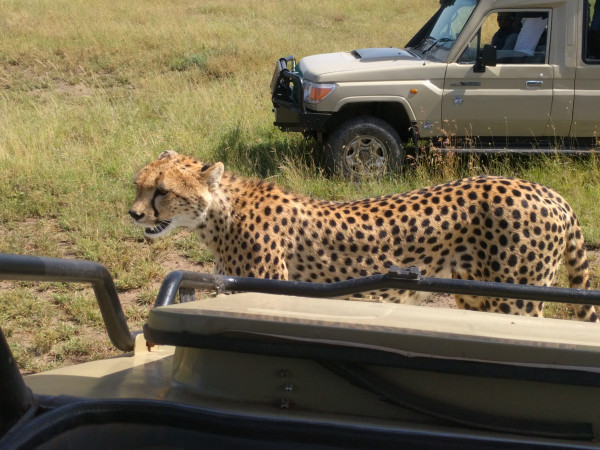
02/18 Lobo - Seronera (Serengeti)
We move south towards Seronera in the heart of the park. We meet a group of gazelles and zebras that run in the grass; Thompson's gazelles jump in a funny way, with stiff legs and head bouncing on the ground several times as if they had springs under their paws. The guide says they do it for fun or as a warning sign for the herd. Moving south, the landscape becomes less green, and the acacia groves decrease, giving way to a more arid prairie that is truly "endless". Before arriving near the campsite, we cross a river where several hippos float. In the meantime, we note that the number of jeeps that travel the slopes has increased and when we arrive at the campsite we find numerous tents. After unloading ours and our luggage, we set off again to explore the park.
Nearby we find a network of slopes, some close to streams with trees and bushes; 10/15 vehicles are parked along the shore and right next to a tree. We too approach, in the shade five or six lionesses doze quietly, tormented by quite a few flies; it is incredible how they let themselves be approached without any sign of annoyance or intolerance, I am much more intimidated. A little further on, near a small stream, two beautiful lion cubs crouching in the bushes. We continue for a while along the bank of a river, another gathering of vehicles, on a tree with a tail hanging down, a leopard is lying; Eric points out that in the tree next to it, wedged between two branches hangs its prey, a poor warthog already half eaten. In an area full of bushes and brushwood we find small antelopes called dik dik, (name that reminds me of an Italian complex of the sixties), they are really small with a nice nose. Then again zebras, various gazelles, antelopes, ostriches, other lions with puppies and so on. Of course the park is quite busy, but on the other hand the sightings are numerous and almost guaranteed. I must say that our guide knows the park's grid patterns well, the space is so much and it also takes us to alternative areas avoiding a little traffic.
Sightings are guaranteed until the evening, in fact when I leave the camping shower with surprise, not far from the structure an elephant detaches some branches from a tree and eats its leaves safely.
Tanzania Parks of the South and Kilwa
SELOUS, MIKUMI, UDZUNGWA MOUNTAINS, estention see KILWA
7 day / 6 night
Three parks in the south, the immense and wild Selous, the coast of ancient Kilwa
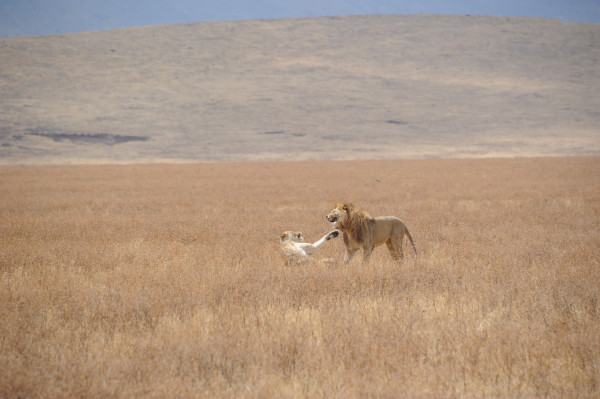
19/02 Serengeti
Today we will continue exploring the park in search of animals and landscapes. As soon as we leave the campsite, groups of giraffes, with a beautiful spotted coat, who despite their height, move in such a sinuous and graceful way. We head south-east, the horizon seems to continue indefinitely, occasionally there are the usual hills formed by large rocky boulders called kopjes, between whose cracks puddles of rainwater are formed where bushes and plants are born. Small animals find refuge here, but also predators who love to be in the shade of these boulders waiting for some prey to pass. In fact, on these rocks we see some lionesses lying idly, and also some species of squirrels without a tail called iraci.
We then arrive in a little visited area and the guide, who has a good eye, manages to identify a cheetah lying in the grass but far enough away. We stop to observe, in the meantime two or three more jeeps arrive, the cheetah begins to move in our direction and with surprise we discover that it has three cubs in tow. He approaches without problems, it is a female, every now and then he stops and scrutinizes the horizon, then a few meters from our jeep naturally he jumps out and climbs on the hood. We are thrilled, even that frightened moment, we have windows and roof open, I sit without saying a word. He looks at us for a moment, scrutinizes the horizon and after 30 seconds, endless for me, goes down from the hood and continues to walk. After recovering from the surprise, not to mention fright, we see that it moves in the grass in the direction of a solitary antelope that is burning the grass unaware of the danger. Practically the cheetah used the jeep's hood as a high ground to locate prey. The three puppies follow at a distance the mother who slowly, hidden by the grass, manages to get very close and with a deadly shot lands her. The antelope that repeatedly rises to escape, is eventually suffocated and gives way. Then come the three cubs who eagerly feed on their prey while the mother rests from the effort of the hunt. It is a rather harsh scene, but the so-called "savannah law" is the death that feeds life. The rather enthusiastic guide tells us that we were lucky, these scenes are difficult to see, although for me, I honestly think that the meeting was a little too close.
We continue the exploration, we see other cheetahs, lions with cubs, and passing again along a tree-lined waterway a leopard resting on the branches of an acacia, hippos and a crocodile camouflaged in the mud and a lot of other animals. Of course we also see birds of various shapes and sizes including large black and white birds numerous on acacia plants. I believe that Serengeti is rightly considered the most wildlife-rich area on the planet.
Tanzania Safaris Northern Circuit parks
SERENGETI,NGORONGORO, TARANGIRE, MANYARA,
7 days / 6 nights
The TOP of the safari, the complete mythical Northern circuit.
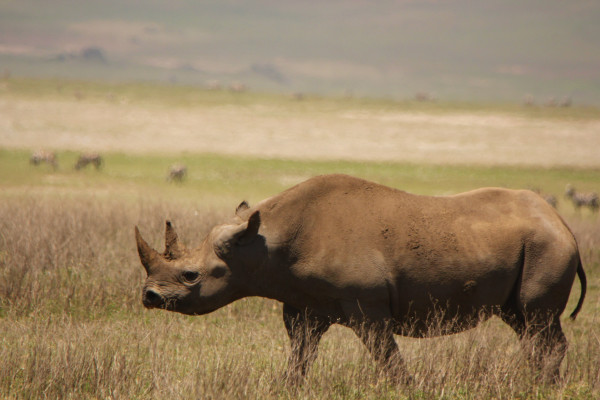
20/02 Serengeti – Cratere Ngorongoro - Karatu
We resume the journey, end our ring tour, moving again towards the Ngorongoro crater where we will visit the bottom. We still see some animals, ostriches, hyenas, groups of wild pharaohs, antelopes and termites of mud, also very high, scattered everywhere. But, in addition to the sightings, the sense of boundless space that these vast plains give you is incredible. Then, before arriving near the gate of Naabi Hill, where the Serengeti park ends and the Ngorongoro park begins, we encounter a flood of zebras. It is the phenomenon of migrations, which every year, following the rhythm of the rainy seasons, sees millions of animals, mainly of wildebeests and zebras, move circularly in search of water and new fertile pastures. From the hills of Naabi Hill the spectacle is truly incredible, they are many and head south-west because the incoming rains will revive the pastures and fill the streams. The guide says that the wildebeests have already passed and we will see many of them in the crater where they will have given birth to their babies. We arrive on the edge of the Seneto road, with a magnificent panorama, which descends steeply into the crater. More than a crater, it is precisely a large caldera formed following the collapse of the volcano which has become inactive. The landscape is quite varied, savannah with low and high grass, woods, swamps, clearings and ponds. We see numerous animals including many wildebeests with the young born a few weeks ago who are breastfed by mothers, and also a good variety of birds. We can also spot two rhinos, animals that unfortunately are at risk of extinction, because in some eastern countries the horn is used as a medicine or aphrodisiac substance, even reaching 100 thousand dollars per kg. Only giraffes are missing because there are no acacia plants here. We stop for a snack break in a wet area with a large pool of water with hippos and various birds, we have to consume food on the jeep because the kites, big dark birds, have discovered these picnics and try to steal your food.
Of course, after crossing the boundless open spaces of the Serengeti, the size of the crater may seem small, the intense traffic, and a high concentration of animals that could make one think of an "open-air zoo", but the visit is still worthwhile.
We go up from the crater from the Lerai road and find ourselves on the initial edge of 5 days ago when we started the ring tour. Another look at the magnificent panorama and we leave the park heading back to Karatu in a lodge where we will spend the night.
Tanzania gruppo parchi del nord e tribù
SERENGETI, MIGRAZIONE, NGORONGORO, TARANGIRE, MANYARA, LAKE EIASY, LAKE NATRON, MONTE MERU
10 giorni / 9 notti gennaio 2020
Un viaggio completo nel Nord della Tanzania, tutti i parchi più gettonati, incontro con le tribù e la Rift Valley
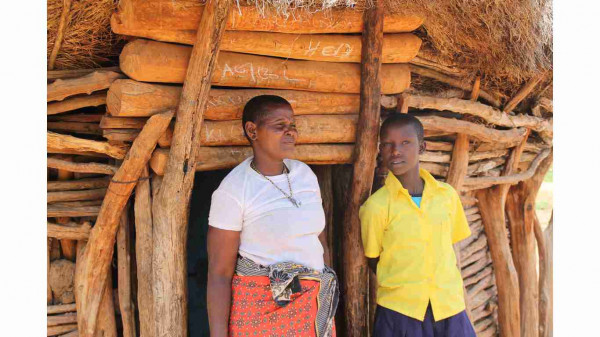
True Africa
What stages will give you real contact with the local population, far from the most tourist routes?
21/02 Karatu - Moshi
Today we will move to Moshi, during the journey we visit "the childrens home" a facility that welcomes orphaned children, whom we learned about from medical friends. We leave the main road after Karatu and we travel 5/6 km between beautiful cultivated hills of a rural area called Rhotia. There are many people in the fields, women with a hoe with children rolled up in a colorful blanket on their backs, I see an ox-drawn plow with long horns, while behind a woman she distributes the seeds in the furrow. It is an almost archaic scene, the rainy season is coming and they must take advantage of it with the work of the land and sowing.
The property is located on top of a hill in a beautiful location. Unfortunately, we are unable to meet the two doctors who manage her, now retired, because they suddenly had to return to Europe for a family bereavement. We still visit the premises with a manager, he tells us that the house started welcoming children in 2007, now there are about 40 guests of different ages. The project was born with the idea of not being completely dependent on donations, but becoming self-sufficient over time, so they developed the "two hills a goal" idea: a lodge that stands on a hill next to it, in an equally beautiful position, which hosts tourists and doctors for seminars, using the profits of this activity to support the expenses of the orphanage. We visit the dormitories, the kitchen, the space for study and play activities. Here the children have assistance, clean water, regular meals, clothes, they can go to school every day and a safe place to sleep. Despite not having a family, they are helped to build their future and find a job. Over time, just to support themselves, they have implemented vegetable gardens with beehives, a stable with a dozen cows, a chicken coop, a bakery and a dairy that supply fresh milk, butter, yogurt and bread also to local shops. They also support and collaborate with local schools with the purchase of desks and materials, create jobs for the community, not only at the lodge but also at the bakery and dairy and the whole village becomes part of the project. Among other things, all these activities are done with attention to sustainability, with solar panels, rainwater collection, biogas plants, division of glass and plastic waste.
Kilimanjaro Trekking Kilimanjaro Machame Route
MACHAME, SHIRA, BARRANCO, BARAFU, UHURU PEACK, MWEKA
7 days / 6 nights
The most used way to reach the roof of Africa
The latest project is called "coffee corner" it is a place, also in a beautiful position between the park of Manyara and the Ngorongoro, where passing tourists can make a stop with coffee, snacks, hot dishes etc. It offers practical training for students who undertake a job in tourism. We are impressed, just a nice project that we too will try to support.
We continue the transfer and stop near Arusha to buy some souvenirs from a social enterprise, which employs people with disabilities, to manufacture objects using recycled materials. There is a laboratory for blowing glass, a weaving space with wooden looms, a sewing workshop that uses disused clothes, one of painting called Tinga Tinga with a slightly naive style, objects made with beads and others made in metal using cans or bottle caps. The objects are beautiful and very original, and the profits are reinvested to create opportunities for hiring people with disabilities.
We stop in Arusha for a snack in a lush public garden. There we meet Daniel, the manager of the agency that organized the trip, say goodbye to the cook and go to Moshi in the Kilimanjaro region where we will spend the night in a lodge surrounded by coffee plantations.
Towards sunset for a few minutes the view opens and we can see the imposing snowy peak of the mountain.
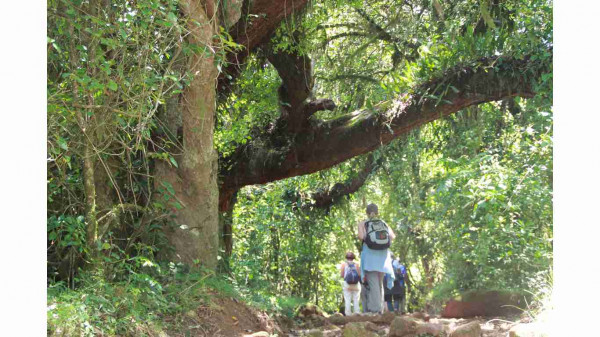
02/22 Kilimanjaro Park
Today we go to the Kilimanjaro National Park, a large protected area that surrounds the mountain of the same name, the highest and symbol of the African continent. It is actually a stratovolcano that includes three peaks formed several million years ago, the Shira, Mewenzi and Kibo, where Uhuru is highest peak at 5,890 meters. Currently the peaks are off, except the Kibo which is considered "dormant" with occasional emission of fumes, vapor trails and weak earthquakes.
The spectacular nature of the panorama is that not belonging to a mountain range, its dimensions are accentuated because its size rises solitary from the cultivated fields of the lower slopes, with the top covered by a perennial glacier. After meeting the guide we go to the western side of the mountain, passing through several countries in a rich agricultural area. Unfortunately, the weather is not the best, we come across a nice downpour which however passes quickly. In the rainforest area, rich in vegetation and tall trees with luxuriant foliage, agricultural exploitation is important, we see large deforested and cultivated areas (carrots and potatoes), with several workers engaged in the harvest; however we also see planting of new trees. The park area starts around 2,700 meters, once you cross the park gate in Londorosi, the road climbs more steeply and the dense vegetation of the forest gives way to lower trees and shrubs. Further on, the slopes of the mountain open and we arrive at the Shira Plateau plateau where we will leave the jeep for an excursion to the moor.
The area is very panoramic, both downwards and upwards, we are at about 3400 meters, but unfortunately in cloudy weather we can only catch a few flashes. We walk along a path in the heathland between dense heather cushions and strange trees called seneci, which at the apex have a rose of fleshy leaves, several shrubs have bloomed giving the landscape beautiful colored shades. We cross three streams, with little water, and we arrive at Shira Camp1, where we find numerous tents of hikers who are facing the climb to the summit. In fact, every year the trekking on Kilimanjaro attracts several hikers, because it is possible to go to the top without using ropes and without knowing particular mountaineering techniques. The guide explains how trekking is organized, the number of porters and guides, the necessary days and the various itineraries to reach the summit.
Kilimanjaro Trekking Marangu route
MARANGU, HOROMBO, KIBO, UHURU PEACK
6 days / 5 nights
Reach the 5895 m of Africa roof by the shortest and most direct route
However, the ascent remains a physically demanding undertaking, especially when walking above 4,000 meters due to altitude and cold problems. Unfortunately, the weather conditions do not allow us to go towards the cone of the Shira Needles volcano at the southern end of the plateau, and we return to the jeep. Then suddenly, for a few moments, the sky opens and we see part of the snowy peak, which seems very close. The guide tells us that in the last 15/20 years there has been a noticeable decrease in ice, which could also lead to the presumption of their depletion in not too distant times. Among the factors of this decrease is global warming, with a decrease in rainfall, and intense deforestation at the slopes.
As we descend, we see beautiful monkeys with long fringes of white fur on the all black body, which move among the foliage of the trees, are the guezera colobus. Although the agricultural exploitation has changed the territory, in these areas there are still elephants, some buffalo, leopards and antelopes. Further down, in the plantations, the guides negotiate the purchase of carrots and potatoes, they say they have made a good deal, the quality is good and they cost less than the market.
Even if the weather hasn't been ours, seeing Kilimanjaro was still exciting.
23/02 Return
Early in the morning we move to Arusha airport, say goodbye and thank Eric, and prepare for boarding. We certainly bring with us the memory of magnificent panoramas, of a wonderful and wild nature, full of bright colors, smells and sounds, but above all the warm hospitality, the composure and the smile of people who, despite countless problems and adversity lead a dignified life.
Mount Meru Trekking and Ngorongoro Highlands
NGORONGORO, EMPAKAI, NAIOBI, ACACIA, NATRON, ARUSHA, MIRIAKAMBA, SADDLE, MERU SUMMIT
10 days / 9 nights
Walk on the paths of the Masai up to 4565 m of Mount Meru
Tanzania Safari The Wonderful South
RUAHA, UDZUNGWA MOUNTAINS, MIKUMI, ISIMILA, estention MAFIA ISLAND
9 days / 8 nights + Mafia Island
A wonderful Safari through the great and wild South
As I look through the window of the plane, the words jambo, pole pole, karibu buzz in my head ... and who knows maybe already a little desire to return.
Tanzania Safaris Northern Circuit parks
SERENGETI,NGORONGORO, TARANGIRE, MANYARA,
7 days / 6 nights
The TOP of the safari, the complete mythical Northern circuit.

